Recent Forum Topics › Forums › The Rams Huddle › Benoit: McVay’s Brilliant Offensive Mind … & more McVay praise from others
- This topic has 6 replies, 3 voices, and was last updated 7 years, 1 month ago by
 zn.
zn.
-
AuthorPosts
-
November 16, 2017 at 7:16 pm #77532
 znModerator
znModeratorSean McVay’s Brilliant Offensive Mind Has Transformed the Los Angeles Rams
Andy Benoit
This much you likely know: At 31, Sean McVay is the youngest head coach in NFL history. This part you likely don’t: McVay is already the league’s best offensive mind. Period. That mind is what earned him his job with the Rams last winter, and it’s what has those Rams sitting atop the NFC West at 7–2.
L.A. scored a mere 14.0 points per game last season, easily the fewest in the NFL, and finished below .500 for a 10th straight season. Through Week 10 of 2017, McVay’s Rams have more than doubled that average, up to 32.9, notching 72 more total points already than in all of ’16. (If the season ended today their points-per-game increase would be the biggest in the modern era.) And this all looks sustainable, given that Jared Goff, the No. 1 pick last year, has seen his passer rating climb from 63.6 (dead last in the league) to 101.5 (No. 7).
If the Rams reach the playoffs in January, marking their first postseason in 13 years and one of the biggest surprises of 2017, they will have McVay to thank.
The rise has been uncommonly swift: Three years playing receiver at Miami (Ohio); straight to the NFL in 2008 as a low-level assistant under the Bucs’ Jon Gruden; a year in UFL Siberia; then a quick ascension with the Redskins—tight ends coach under Mike Shanahan, offensive coordinator under Jay Gruden, who eventually let him call the plays. Gruden’s long leash was crucial in McVay’s development, but the Shanahan years seem to have been the most formative.
Shanahan believed in marrying his running and passing games, such that all of his plays initially looked the same. The scheme that best fits this approach begins with an outside-zone ground game, where your offensive line moves in unison. Here, a defense typically flows with the zone blocking, which makes the scheme particularly conducive to play-action.
The best zone offense in recent memory? That belonged to the 2016 Falcons, coordinated by Shanahan’s son, Kyle, who’d been on that old Redskins staff with his dad. . . and McVay. Three days after Shanahan’s Atlanta offense played in Super Bowl LI, last February, McVay snapped up the Falcons’ quarterbacks coach, 37-year-old Matt LaFleur, to be his own offensive coordinator. (LaFleur was also on that Shanahan staff in Washington.) Together, McVay and LaFleur have adopted many of Atlanta’s zone-running and play-action concepts.
The play-action, in particular, has helped Goff immensely. The run fake (against predictable first- and second-down defensive looks) slows down pass rushers and manipulates linebackers and safeties. Under McVay, these are timing and rhythm throws, almost always with reads to just one side of the field. And it’s paying off. This season, according to Football Outsiders, the Rams are using play-action on 25% of their dropbacks (fourth-most in the league) and averaging 8.5 yards per play (11th-most).
Much of that play-action success stems from McVay’s play-calling rhythm. His feel for this is uncanny. Watching Rams film can be like reading a story with a great motif; everything correlates to an underlying theme. McVay will run plays on his third series that look like plays he ran on his first and second series—but only initially. They morph as they unfold.
McVay is a master too at conjuring up downfield route combos that complicate and blur the responsibilities of zone defenders. That feeling you get when you’re walking down the sidewalk and you realize your path is shared with an oncoming stranger—that’s how playing zone coverage against McVay’s offense feels. As a defender, it can put you in a bind.
So can McVay’s formations. This team, more than any other, aligns its receivers tight to the formation, inside the field numbers. Those tighter splits eliminate the sideline (an imposing 12th defender), giving each L.A. receiver a two-way go. Defenders must cover more ground and more route possibilities; because of the clustered spacing, they’re more susceptible to rub and pick routes. McVay builds a lot of these rubs and picks into the beginnings of his plays by aligning receivers close to one another, and those receivers get open quickly. It’s what the Patriots have perfected in recent years. It’s how you beat man coverage.
Something else McVay pilfered from the Pats: the use of presnap motion. Often, a Rams receiver will align wide and motion down into the clustered tight split. This puts defenders on their heels. They must play with more cushion, and their response almost always tells Goff whether he’s facing man or zone coverage. If a defender follows the motioning receiver, it’s typically man; if he doesn’t, it’s zone. This information is particularly valuable in McVay’s system, in which he’ll often have two sets of route combinations: man-coverage-beaters on one side of the field, zone-beaters on the other. He has an answer for almost everything.
Let’s be fair about this all: As primed as McVay is to take L.A. to the next level, he is overseeing a more talented group than the one Jeff Fisher led in 2016. Goff is a year older, the O-line is stabilized by veteran free-agent pickups at left tackle and center, the receiving corps is totally revamped.
The biggest difference, though, is the way this offense is being orchestrated. A commanding play-caller makes a quarterback more comfortable. And a comfortable quarterback is one who will play with pocket poise and decisiveness in those critical moments when play design alone isn’t enough. The Rams are still rebuilding, but with a gifted coach, the foundation for excellence is already in place.
November 16, 2017 at 7:26 pm #77533 wvParticipant
wvParticipant“…McVay’s system, in which he’ll often have two sets of route combinations: man-coverage-beaters on one side of the field, zone-beaters on the other…”
Interesting.
w
vNovember 16, 2017 at 7:38 pm #77536 InvaderRamModerator
InvaderRamModeratorShanahan believed in marrying his running and passing games, such that all of his plays initially looked the same.
it makes sense to do that. do other offenses not do this? i wonder what boras did. was he telegraphing what the offense doing on all his plays?
Together, McVay and LaFleur have adopted many of Atlanta’s zone-running and play-action concepts.
i wondered if they might incorporate some of the falcons offense into this offense. i’m glad that this is the case.
November 16, 2017 at 7:38 pm #77537 znModeratorNovember 16, 2017 at 8:05 pm #77541
znModeratorNovember 16, 2017 at 8:05 pm #77541 znModerator
znModeratorA close look at the Rams’ most unique play designs
Alden Gonzalez
THOUSAND OAKS, Calif. — There have been so many times when Sean McVay has cued up a distinctive play in an offensive meeting and his Los Angeles Rams players have scoffed. No way, they think, this will actually work in an NFL game.
Todd Gurley will admit to that.
“Yeah,” the Rams’ star running back said, “that sounds like me on every play. I’m like, ‘Aw, this ain’t gonna work.'”
Then it does. The Rams will run it in practice, and it’ll look good. Then they’ll run it in a game, and it’ll work. It has happened often throughout the course of these first nine games. The Rams are 7-2 for the first time since 2001. They’re first in the NFL in points per game one season after finishing last in the NFL in points per game, and only one team has ever had a turnaround like that.
It’s a product of savvy offseason additions, a significantly improved quarterback and a new, offensive-minded coaching staff.
It’s also rooted in innovative play design.
“We have so much stuff in our offense, man,” Gurley said. “It’s definitely hard to defend when you’re doing stuff like that.”
Below, we identified five of the most unique, successful plays designed by the Rams’ offensive staff this season. Offensive coordinator Matt LaFleur walked us through it.
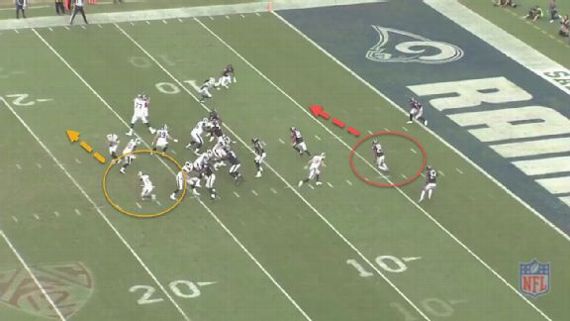

The situation: First and 10, ball at the Texans’ 12-yard line, Rams leading 23-7 with just over a minute remaining in the third quarter.
The play: The Rams stack Robert Woods and Cooper Kupp on the right side and leave Sammy Watkins alone on the left, all three receivers tight with the formation. Jared Goff fakes a handoff to Gurley, and Woods fakes as if he is going to run a jet sweep to the other side of the field. As soon as Goff pulls the ball back, Woods whips back to the right side of the field, catches a pass out in the flat and runs in for a touchdown.
Worth noting: This one plays off two designed inside-zone running plays that look very similar. In one, Goff fakes the handoff to Woods on the jet sweep (referred to as a “ghost motion”) and Gurley takes the ball and runs up the middle. In the other, Woods takes the ball on the jet sweep and darts with it to the other side of the field. The third version completely fools the Texans. The inside corner (circled in red) takes Woods (circled in yellow) and follows him to the other side of the field. By the time Woods gets the ball back, the Texans’ corner is too far removed, leaving lots of empty space.
LaFleur: “This is where game-planning is so important. You play the Houston Texans, you know they’re a big man-coverage team down in the red zone, especially from the 20 to the 10. So we figured that whoever was in man-to-man coverage on Robert, he’s going to think he’s either getting the ball or is going around on that ghost [motion]. So we were hoping that he would travel with him all the way back across the formation. Those guys actually comboed — Robert and Cooper Kupp — and you can see the inside [cornerback] goes with Robert, the outside guy goes with Cooper Kupp. So that left Robert all alone in the flat.”
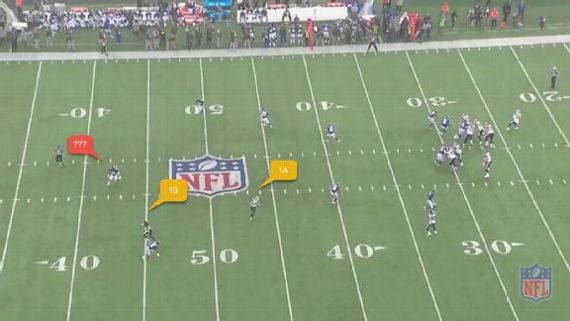
The situation: Second and 6, ball at the Rams’ 33, Rams leading Giants 17-7 near the 7-minute mark of the second quarter.
The play: Watkins is isolated outside on the left and Kupp is lined up tight with the formation on the right. Kupp runs a high crossing route. Watkins goes deep, running what the Rams call a “pylon-post” — a double move that has him fake to the outside and turn back inside. Goff rolls slightly to his right, then looks left and uncorks a deep ball to Watkins that results in a 67-yard touchdown.
Worth noting: The Rams run a lot of keepers, and this play starts off creating that illusion before Goff turns his attention to the other side of the field. In this play, he’s supposed to read Giants safety Landon Collins (identified in red). If he’s deep, the throw goes to Kupp underneath (outlined as “1A”). If he plays up, it goes deep to Watkins (“1B”).
LaFleur: “This is why I think it’s an unbelievable play by [Goff]. My eyes in the box, as soon as I see that safety deep, I was like, ‘Oh no, he’s going to throw this high cross [to Kupp].’ … But to Jared’s credit, he said he saw Collins coming out flat with his numbers to him. When Sammy leaned on the pylon route, then went back out to the post, he said, ‘There’s no way he [Collins] is going to be able to beat [Watkins] over the top.’ He thought he was out of position. No. 1, great protection. It all starts with the protection. No. 2, it was a great route by Sammy Watkins how he didn’t lose any speed. And then it was just an unbelievable throw.”
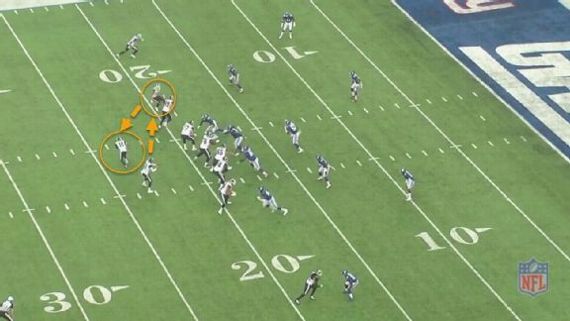

The situation: Second-and-goal, ball at the Giants’ 18, score tied at 7 in the final seconds of the first quarter.
The play: Kupp is the inside receiver, with Woods lined up outside on the left. Tavon Austin is in the backfield, with Goff set up in the shotgun. At the snap, Goff throws the ball to Kupp, who then flips it to Austin as he comes up behind him for what’s casually referred to as a “hitch and pitch.” Austin runs to the outside and picks up an additional nine yards.
Worth noting: LaFleur, midway through his 10th season in the NFL, had never seen a play like this. Rams tight ends coach Shane Waldron, who handles red zone plays as part of the team’s game-planning, suggested it as a unique way to get Austin the ball. LaFleur said he was “a little lukewarm to it at first” because the ball was moving around too much. Then the Rams ran it in practice and looked good doing it, so they put it in.
LaFleur: “We’ve run a lot of screens to Cooper Kupp. This was just a nice, safe red zone play, we felt like. We thought that by just throwing it out to Cooper Kupp, the defense would just converge on him. And we thought, ‘What an easy way to get Tavon Austin to get the ball in space.’ Granted, it’s a [9]-yard gain; we were hoping for a touchdown. But it was still a very positive play here. And it plays off some of the screens that we run. … That play, I can’t say enough about what the guys on the outside did with their blocks. [Woods and tight end Tyler Higbee, boxed in on the second image.]”
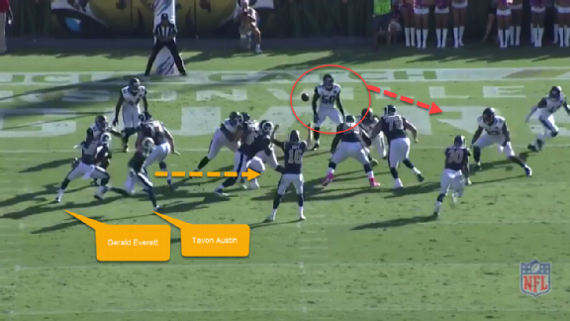
The situation: Second and goal, ball at the Jaguars’ 4, Rams trailing 14-10 in the final seconds of the first quarter.
The play: Tight end Gerald Everett lines up tight with left tackle Andrew Whitworth. Austin streaks across the field pre-snap, creating the threat of taking the ball on a jet sweep. Goff sets up in the shotgun and takes the snap, which comes out a little high. He immediately shovels it to Everett, who runs right up the middle for the score.
Worth noting: This is a classic case of Austin’s presence making an impact without him touching the ball. It’s evident in watching Jaguars middle linebacker Telvin Smith (circled in red). Smith follows Austin to the right side of the field, and it creates an opening up the middle that Everett bursts through for his first career touchdown.
LaFleur: “Another pretty relatively safe play where we’re faking the fly sweep with Tavon here to try to draw the defense to get them outside, and then we’re going to shovel it back inside to Gerald. That was just a great job, No. 1, by Jared of catching the ball, and then flipping it to Gerald. It was pretty good blocking up front. It gave [Everett] a little bit of a crease, and he did the rest. … Watch the flow of the linebackers. [Number] 50, he’s flying outside with the threat of the jet sweep. It’s a good play design, it’s a safe play, and obviously it worked, so it’s a successful play, as well.”
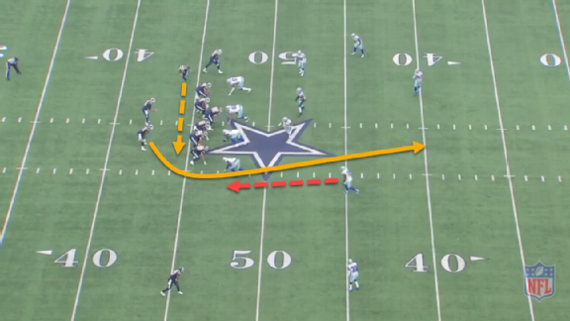
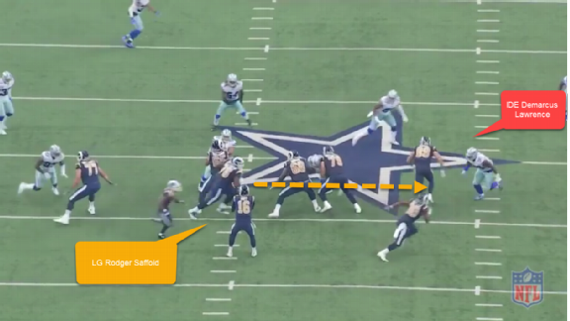
The situation: First and 10, ball at the Rams’ 47, Rams trailing the Cowboys 24-19 at the three-minute mark of the third quarter.
The play: Goff sets up in the shotgun with Gurley next to him. At the snap, Austin once again comes across the field in ghost motion. Goff fakes to him, and Gurley runs a seam route. Goff delivers a strike to Gurley after he streaks past the two underneath defenders, and Gurley does the rest, turning it into a 53-yard touchdown.
Worth noting: The Rams borrowed this play from the Chiefs, who borrowed it from the Patriots. Once again, Austin (shown in the first image about to come across the field) is able to draw coverage in his direction. This time it’s the Cowboys’ safety (shown in the first image creeping forward). That allows Gurley to dart past him and into the seam. But another key to this play is left guard Rodger Saffold (shown in the second image). The Rams pulled Saffold and had him pick up NFL sack leader DeMarcus Lawrence as he came around the edge. The timing of the block was perfect.
LaFleur: “Having Tavon Austin in this case be a great decoy helps draw the coverage up, and we were able to slip Todd in the seam. This was awesome anticipation and accuracy by Jared. And it was a hell of a catch by Todd, just to navigate through the secondary — great run after the catch, no doubt about that. … In pulling Rodger here — it’s a gap-scheme protection, where you’re pulling a guy, you’re bringing everybody down, you see he’s kicking out the end, and look at that pocket. It’s a great job, great execution by the five bigs up front.”
November 17, 2017 at 10:29 pm #77611 znModeratorNovember 18, 2017 at 1:19 am #77614
znModeratorNovember 18, 2017 at 1:19 am #77614 znModerator
znModerator -
AuthorPosts
- You must be logged in to reply to this topic.

